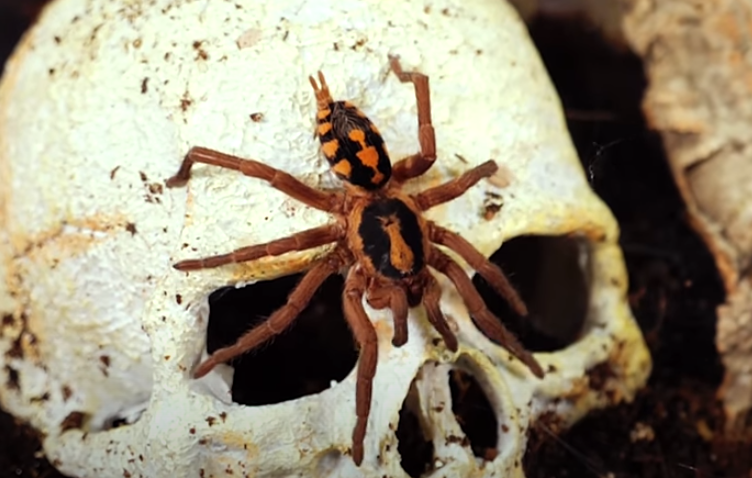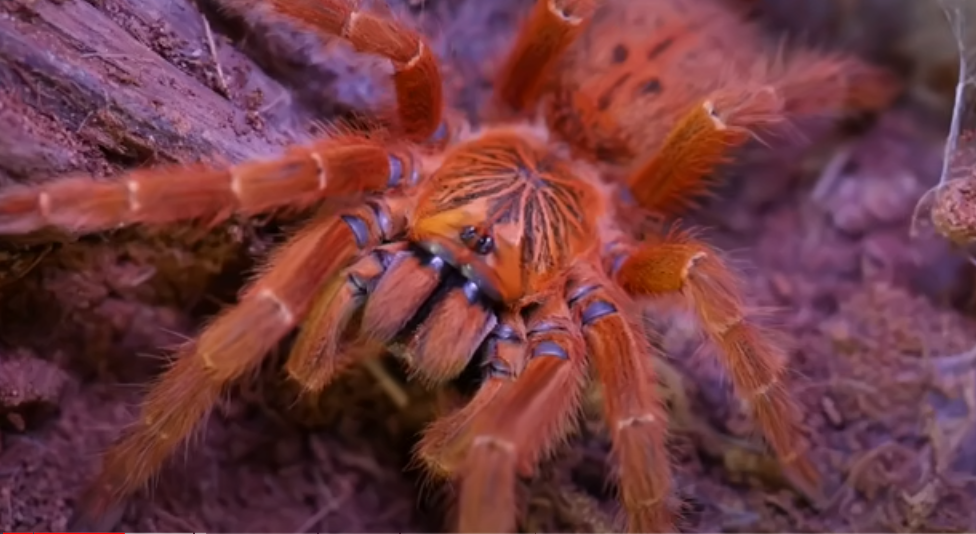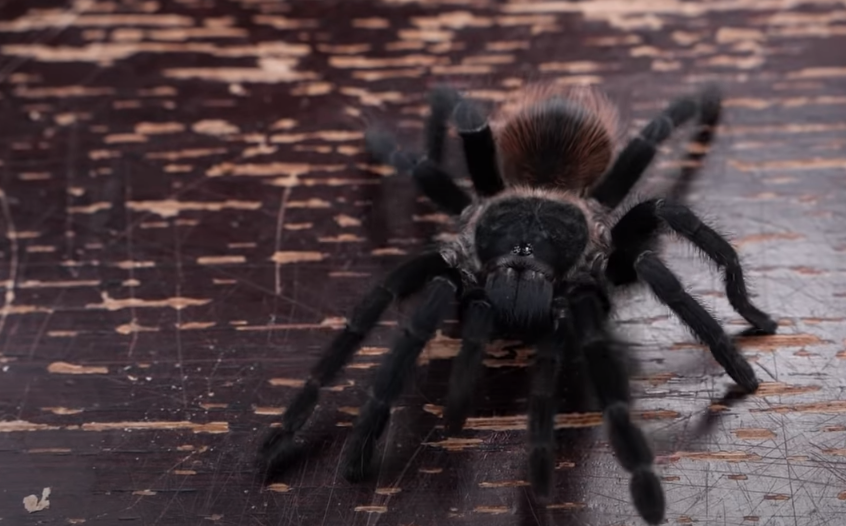The scientific name of Curly Hair Tarantula is Brachypelma albopilosum. This tarantula is large spider burrowing species and a terrestrial inhabitant of the neotropics. The beautiful fact about this tarantula is the curly hair that covers its body. Even if all species of tarantulas do have hair, the distinction of the lighter colored hairs and the different curl gives the curly hair tarantula a unique emergence. They are ground-dwelling, calm, beautiful spiders, and like many other tarantulas in the genus Brachypelma.
Table of Contents
Toggle
The infantile is inclined to be a bit on the shy side, but as the adult, this species will spend more and more time out in the open areas, though they may always run away rapidly to a burrow if they feel threatened. When the tarantulas are alarmed, they flicked urticating hairs. As they get old, this species usually calms down and bears occasional behavior.
| Scientific Name: | Tliltocatl albopilosus |
| Common Name: | Curly Hair, Honduran Curly Hair, Nicaraguan Curly Hair Tarantula |
| Type: | Terrestrial |
| Category: | New World |
| Body Length: | 3” (8cm) |
| Location: | Honduras, Nicaragua, Costa Rica |
| Growth Rate: | Slow |
| Life Expectancy: | Females 25 years / Males 5 years |
| Experience Level: | Beginner |
Physical Appearance of Curly Hair Tarantula
The Honduran Curly Hair Tarantula is a giant spider with curly hairs on its body. This spider has an attractive dark-colored body with a golden-bronze sheen due to its long golden curly hairs that envelop the body. This tarantula has a dark-colored round body wrapped with long strands that have slight and beautiful curls. Most furs are dark brown to black, but some are golden, which shines like gold. This color gives the spider an overall bronze sheen shade, which is very attractive. These spiders are generally easy to care for because of their calm, hardy, and easy temperament. This characteristic of these spiders makes them ideal for those who are new to raising tarantulas as pets.
Size
Adults of this species range from 4-6 (127-152.4mm) inches.
Behaviour and Temperament
The passive behavior of these tarantulas makes it a personal favorite among those who like handling their spiders. As New World tarantulas, whenever they feel threatened, they are more likely to kick off some of the chunky urticating (stinging) hairs from their abdomen instead of delivering a nibble. Despite the term, these are not actually “hairs.” It is a misnomer; only mammals have natural hairs on their bodies.
These spiders are fine, skinny expansions from the spider’s exoskeleton that have a gentle poison that can irritate if exposed to the skin of humans. They can sometimes build up a bald mark on their abdominal area due to repeated kicking, one of the animal’s primary defense mechanisms. Though, the “hairs” will be refilled after the successive molt of the spider. The curly hair tarantula has poison and can bite if it feels threatened, as do all tarantulas. The pain has been illustrated as similar to that of a bee sting. You should be tremendously cautious when handling your tarantula if you are known to be severely affected by bees.

Life expectancy
Usually, males live to be 5-10 years old, while females live 20-25 years. This is also known as the lifespan of wild tarantulas.
Adaptations
- A tarantula uses its pair of teeth to inject poison into its prey to kill it.
- If the tarantula is under stress, this can drop or fling, urticating hairs on the sides and back of their abdomens. These hairs are itchy and can irritate the nose, mouth, and eyes of killers and cause rashes on the human body.
- Although tarantulas do not have bones, they have hard outside coverings called exoskeletons that give their bodies shelter and support.
- Tarantulas can spin silk, and they use the silk to line their burrows and protect their eggs. Unlike other spiders, they do not use silk to create webs that grab their victim.
Housing
A secure enclosure for an adult curly hair tarantula is the floor space roughly the size of a 10-gallon aquarium is more than sufficient. As tarantulas are a terrestrial species, horizontal space is always more significant than height, as too high of an enclosure can result in falls and redundant injury to your spider. Unlike many other species, the curly hair tarantula can frequently be seen out and about inside its enclosure.
It is essential to provide your tarantula with sections to hide, such as howl, wood pieces, or even small jars, which helps spiders hide. The curly hair will tunnel in its substrate, lining the outer area and inner walls with its silk to build a home for itself. The required intensity of cradling for the curly hair is about 3 to 4 inches. The Tliltocatl albopilosus are known as home decorators as they “redecorate” their enclosure and can be caught many times moving a bunch of dirt and décor. To maintain humidity and temperature levels, plastic or acrylic enclosures are better at keeping both.

Feeding
These Nicaraguan Curly Hair Tarantulas aren’t considered fussy eaters, as they are opportunistic feeders in the feral. In their native range, anything tiny sufficient to be overwhelmed by the tarantula is the blond game. Though, when preparing the curly hair tarantula diet, it is essential to take specific safety measures. It is vital to offer appropriate-sized feeders to decrease the danger of injuries during the feeding procedure.
Different insects such as mealworms, Dubai roaches, and live crickets are simply obtainable curly hair spider food available at many pet stores. They get the proper nutrients when they offer a variety of feeder insects for feeding. It ensures that your feeders are “gut-loaded” if they are fed healthy; your pet is fed healthy, too. Sometimes you should offer a tiny pinky mouse as a treat, but many keepers warn against feeding your tarantulas things that are very rich in calcium. Do not provide your curly hair tarantula insects or any kind of small feeder from outside.
Water & Humidity
Curly Hair Tarantulas require a higher level of humidity. 70% humidity is best for these species. It is suggested that you have both a digital thermometer and hygrometer in your enclosure to check these conditions regularly. The tarantula can have difficulty molting if the section gets too dry, which can cause death and disfigure your spider. Keep a small water dish or bottle cap full of water in the enclosure to maintain humidity level. The chamber can also be misted. Misting can be behind the walls of the section, so the substrate sucks it up.
Heating & Lighting
These tarantulas do not need any heating lamps and UV lighting, and they need a day-night cycle. Keep away your spider’s enclosure from direct and too much sunlight. Sunlight can cause cooking your spider in its house. You should keep the temperature of the section around 75-80 degrees. For more information about tarantula visit here.
Molting
If you observe that your Tliltocatl albopilosus is refusing to eat or hiding more than usual, and is slowing down, do not be panic. It could be entering the somewhat lengthy procedure of a molt. In this process, it will produce and shed its whole exoskeleton. When you see two tarantulas in the enclosure, the second one will be the molt, which must be taken away from the section. Through its molt, a knowledgeable custodian can find out the sex of a tarantula. If you observe that your curly hair tarantula appears to be molting, keep your tarantula’s water dish filled and eliminate any live feeders. The humidity facilitates this procedure, as too dry of an environment could be this species’ ruin.
If you observe your spider on its back with its legs up, this is the establishment of the molting process. Although, if you keep that your tarantula is sitting with its legs tucked under itself, or if it has a withered and pitiable-looking abdomen, you should ask for the help of an exotics veterinarian to identify your tarantula’s situation correctly.
Common Health Problems
Tarantulas usually don’t face significant health problems when fed the proper diet and kept in a suitable environment. But if your spider has become tired or isn’t eating, consult your veterinarian to help you diagnose the root cause of its condition.
Mostly, those actions are a sign that your spider is getting ready to molt. During the process of molting, a tarantula discards its exoskeleton and forms a new one. The whole process can take weeks, but the authentic molt is complete in a few hours. The new exoskeleton must solidify to become defensive for the tarantula. It should or otherwise seems irregular if you think your spider’s molt is taking a long time.
Fun facts of Curly Hair Tarantula
- Tarantula venom is seldom harmful to humans, although they are nasty creatures. A tarantula bite has never killed anyone.
- The term “spiderling” refers to a juvenile spider.
- A tarantula’s exoskeleton does not expand. The tarantula sheds its exoskeleton as it becomes more prominent. Because tarantula’s bodies are so delicate that prey animals may damage them, captive tarantulas are not fed for about a week following molting.
- Spiders are not insects but arachnids. The number of legs that spiders and insects have is one of the most significant differences between them.
To know more interesting facts about tarantulas visit here.





